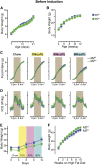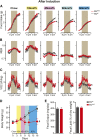Adult-onset deficiency of acyl CoA:monoacylglycerol acyltransferase 2 protects mice from diet-induced obesity and glucose intolerance
- PMID: 25535286
- PMCID: PMC4306691
- DOI: 10.1194/jlr.M055228
Adult-onset deficiency of acyl CoA:monoacylglycerol acyltransferase 2 protects mice from diet-induced obesity and glucose intolerance
Abstract
Acyl-CoA:monoacylglycerol acyltransferase (MGAT) 2 catalyzes triacylglycerol (TAG) synthesis, required in intestinal fat absorption. We previously demonstrated that mice without a functional MGAT2-coding gene (Mogat2(-/-)) exhibit increased energy expenditure and resistance to obesity induced by excess calories. One critical question raised is whether lacking MGAT2 during early development is required for the metabolic phenotypes in adult mice. In this study, we found that Mogat2(-/-) pups grew slower than wild-type littermates during the suckling period. To determine whether inactivating MGAT2 in adult mice is sufficient to confer resistance to diet-induced obesity, we generated mice with an inducible Mogat2-inactivating mutation. Mice with adult-onset MGAT2 deficiency (Mogat2(AKO)) exhibited a transient decrease in food intake like Mogat2(-/-) mice when fed a high-fat diet and a moderate increase in energy expenditure after acclimatization. They gained less weight than littermate controls, but the difference was smaller than that between wild-type and Mogat2(-/-) mice. The moderate reduction in weight gain was associated with reduced hepatic TAG and improved glucose tolerance. Similar protective effects were also observed in mice that had gained weight on a high-fat diet before inactivating MGAT2. These findings suggest that adult-onset MGAT2 deficiency mitigates metabolic disorders induced by high-fat feeding and that MGAT2 modulates early postnatal nutrition and may program metabolism later in life.
Keywords: coenzyme A; dietary fat; energy expenditure; fat absorption; metabolic programming; monoacylglycerol acyltransferase 2; triacylglycerol.
Copyright © 2015 by the American Society for Biochemistry and Molecular Biology, Inc.
Figures







Similar articles
-
Intestine-specific deletion of acyl-CoA:monoacylglycerol acyltransferase (MGAT) 2 protects mice from diet-induced obesity and glucose intolerance.J Biol Chem. 2014 Jun 20;289(25):17338-49. doi: 10.1074/jbc.M114.555961. Epub 2014 May 1. J Biol Chem. 2014. PMID: 24784138 Free PMC article.
-
Deficiency of MGAT2 increases energy expenditure without high-fat feeding and protects genetically obese mice from excessive weight gain.J Lipid Res. 2011 Sep;52(9):1723-32. doi: 10.1194/jlr.M016840. Epub 2011 Jul 6. J Lipid Res. 2011. PMID: 21734185 Free PMC article.
-
Intestine-specific expression of MOGAT2 partially restores metabolic efficiency in Mogat2-deficient mice.J Lipid Res. 2013 Jun;54(6):1644-1652. doi: 10.1194/jlr.M035493. Epub 2013 Mar 27. J Lipid Res. 2013. PMID: 23536640 Free PMC article.
-
Ghrelin O-acyltransferase (GOAT) and energy metabolism.Sci China Life Sci. 2016 Mar;59(3):281-91. doi: 10.1007/s11427-015-4973-6. Epub 2016 Jan 6. Sci China Life Sci. 2016. PMID: 26732975 Review.
-
Glycerolipid acyltransferases in triglyceride metabolism and energy homeostasis-potential as drug targets.Endocr Metab Immune Disord Drug Targets. 2012 Jun;12(2):197-206. doi: 10.2174/187153012800493459. Endocr Metab Immune Disord Drug Targets. 2012. PMID: 22385114 Review.
Cited by
-
Mice lacking ARV1 have reduced signs of metabolic syndrome and non-alcoholic fatty liver disease.J Biol Chem. 2018 Apr 20;293(16):5956-5974. doi: 10.1074/jbc.RA117.000800. Epub 2018 Feb 28. J Biol Chem. 2018. PMID: 29491146 Free PMC article.
-
Monoacylglycerol acyltransferase-2 inhibits colorectal carcinogenesis in APCmin+/- mice.iScience. 2024 Jun 6;27(7):110205. doi: 10.1016/j.isci.2024.110205. eCollection 2024 Jul 19. iScience. 2024. PMID: 39055928 Free PMC article.
-
Monoacylglycerol O-acyltransferase 1 lowers adipocyte differentiation capacity in vitro but does not affect adiposity in mice.Obesity (Silver Spring). 2022 Nov;30(11):2122-2133. doi: 10.1002/oby.23538. Obesity (Silver Spring). 2022. PMID: 36321276 Free PMC article.
-
Redundant roles of the phosphatidate phosphatase family in triacylglycerol synthesis in human adipocytes.Diabetologia. 2016 Sep;59(9):1985-94. doi: 10.1007/s00125-016-4018-0. Epub 2016 Jun 25. Diabetologia. 2016. PMID: 27344312 Free PMC article.
-
Hypertriglyceridemia: Molecular and Genetic Landscapes.Int J Mol Sci. 2024 Jun 8;25(12):6364. doi: 10.3390/ijms25126364. Int J Mol Sci. 2024. PMID: 38928071 Free PMC article. Review.
References
-
- Coleman R. A., Lee D. P. 2004. Enzymes of triacylglycerol synthesis and their regulation. Prog. Lipid Res. 43: 134–176. - PubMed
-
- Yen C. L., Farese R. V., Jr 2003. MGAT2, a monoacylglycerol acyltransferase expressed in the small intestine. J. Biol. Chem. 278: 18532–18537. - PubMed
-
- Cao J., Hawkins E., Brozinick J., Liu X., Zhang H., Burn P., Shi Y. 2004. A predominant role of acyl-CoA:monoacylglycerol acyltransferase-2 in dietary fat absorption implicated by tissue distribution, subcellular localization, and up-regulation by high fat diet. J. Biol. Chem. 279: 18878–18886. - PubMed
MeSH terms
Substances
Grants and funding
LinkOut - more resources
Full Text Sources
Medical
Molecular Biology Databases

